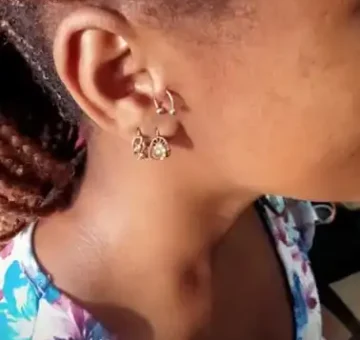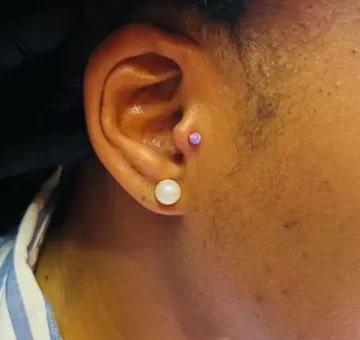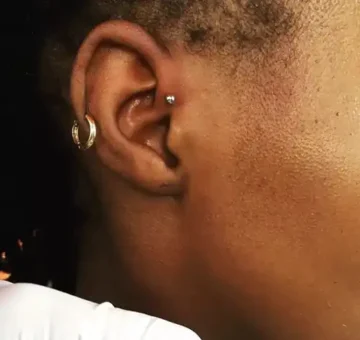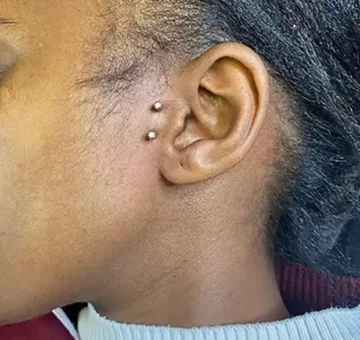Tragus Piercing in Nairobi, Kenya
A tragus piercing is a type of ear piercing that goes through the small, rounded piece of cartilage, called the tragus, which partially covers the ear canal. Located at the front of the ear, the tragus is a thicker section of cartilage, which makes this piercing unique compared to lobe piercings.
This piercing is popular for its subtle, edgy look and the range of jewelry it can accommodate. Due to its unique placement, it stands out without being too flashy, making it a favorite among ear cartilage piercings.
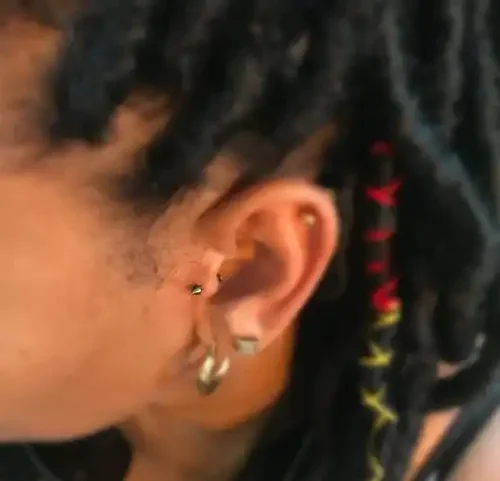
Tragus Piercings
Key Features of a Tragus Piercing:
- Placement: Positioned on the cartilage just in front of the ear canal.
- Jewelry Options: Typically, small studs, hoops, or barbells are used, chosen for comfort and minimal irritation.
- Pain Level: Often described as moderately painful because of the thickness of the cartilage. However, the pain is generally quick and manageable.
- Healing Time: Around 3 to 6 months, depending on care and individual healing response.
Variations of Tragus Piercings
While the term “tragus piercing” typically refers to a specific location on the ear, there are variations and additional ear piercings that involve the tragus area or nearby regions. Here are some types of tragus and tragus-related piercings:
- Traditional Tragus Piercing: This is the standard tragus piercing, where the jewelry is inserted through the tragus, the small piece of cartilage that protrudes in front of the ear canal.
- Double Tragus Piercing: Two tragus piercings are done on the same ear, often vertically aligned or at a slight angle. This style adds a unique look to the tragus area.
- Surface Tragus Piercing: Sometimes referred to as a “surface tragus,” this involves placing a barbell or surface bar horizontally along the flat surface of the tragus, rather than going through the cartilage.
- Vertical Tragus Piercing: In a vertical tragus piercing, the jewelry is inserted vertically through the tragus, starting at the top or bottom and exiting at the opposite end. It can create an interesting visual effect.
- Anti-Tragus Piercing: The anti-tragus is the small bump of cartilage opposite the tragus, on the outer part of the ear. An anti-tragus piercing involves piercing this area, typically with a small stud or hoop.
- Forward Helix Piercing: Although not precisely a tragus piercing, the forward helix is located on the upper part of the ear, just above the tragus. It can be done as a single piercing or in a cluster, often using small studs or rings.
- Snug Piercing: The snug piercing goes through the cartilage along the inner ridge of the ear, parallel to the tragus. It’s not part of the tragus itself, but it’s a nearby piercing option.
- Rook Piercing: The rook piercing is situated above the tragus, in the fold of cartilage in the middle of the ear. It is not directly related to the tragus but is another popular ear piercing.
- Daith Piercing: The daith piercing is located in the innermost fold of cartilage above the ear canal, near the tragus. While it’s not part of the tragus, it’s sometimes considered a companion to tragus piercings.
Each of these piercings has its own unique look and placement, offering various options for ear decoration and personal style. Keep in mind that the suitability of a specific piercing may depend on your ear’s anatomy and the guidance of a professional piercer. It’s essential to consult with an experienced piercer to determine the best piercing type for your preferences and anatomy.
Tragus Piercing Procedure
The tragus piercing procedure is straightforward but requires precision because of the cartilage’s thickness and location near the ear canal. Here’s a step-by-step look at what you can expect during the procedure:
- Preparation and Cleaning
– Our piercer will clean the ear thoroughly, especially the tragus area, with an antiseptic solution to reduce the risk of infection.
– They’ll then mark the piercing site with a dot, allowing you to confirm the exact placement before proceeding. - Sterilization of Equipment: All equipment, including the needle and jewelry, is sterilized to ensure a safe, hygienic process.
- Piercing the Tragus
– Using a small, hollow needle (usually 18 or 16 gauge), our piercer will quickly push the needle through the tragus.
– Some people feel a sharp pinch or pressure as the needle goes through; the cartilage’s thickness can make this part feel intense, but the process is usually very fast. - Inserting Jewelry
– After the needle is removed, our piercer will insert the chosen jewelry, usually a barbell or captive bead ring, as these work well for initial healing.
– The jewelry is carefully secured, ensuring it’s placed comfortably and won’t shift excessively during the healing process. - Aftercare Instructions: The piercer will provide detailed aftercare instructions, emphasizing the importance of cleaning with a saline solution and avoiding unnecessary touching or pressure on the area.
Considerations before getting a Tragus Piercings
Before getting a tragus piercing or any other type of body piercing, there are several important considerations to keep in mind. These considerations will help ensure that you make an informed decision and have a positive piercing experience:
- Piercing Studio: Choose a reputable and professional piercing studio or piercer. Look for a place with a clean and sterile environment, and experienced staff. At Rebel Inks Tattoo Removal and Piercings Parlour we have extensive experience and experienced team that is geared to offer you the best services Contact Us Today for further consultation and scheduling
- Allergies and Sensitivities: Discuss any known allergies or sensitivities you have with your piercer. This information is crucial in selecting the appropriate jewelry materials, as some people may react to certain metals.
- Medical History: Inform your piercer about your medical history, especially if you have any underlying health conditions or are taking medications that might affect your healing process.
- Anatomy Assessment: Every person’s ear anatomy is unique. A professional piercer will assess your tragus’s size, shape, and location to determine the best placement for the piercing.
- Pain Tolerance: Consider your pain tolerance. While tragus piercings are generally not extremely painful, there will be some discomfort during the process.
- Healing Time: Understand that tragus piercings, like all body piercings, require a healing period. Be prepared for the commitment to proper aftercare and potential healing complications.
- Aftercare: Ask your piercer about the specific aftercare instructions you should follow. Proper cleaning and care are essential to prevent infection and ensure a successful healing process.
- Jewelry Selection: Discuss your jewelry options with your piercer. At Rebel Inks Tattoo Removal and Piercings Parlor, our piercers will recommend suitable jewelry types, sizes, and materials based on your preferences and anatomy.
- Lifestyle Considerations: Consider your daily activities and lifestyle. Activities like contact sports, swimming, or wearing over-ear headphones may need to be adjusted during the healing process.
- Long-Term Commitment: Remember that a piercing is a long-term commitment. Even after the initial healing period, you’ll need to continue caring for your piercing and may need to change jewelry periodically.
- Infection Risk: Be aware of the risk of infection and other potential complications. Keep an eye out for any signs of infection (e.g., redness, swelling, discharge) and seek prompt medical attention if you suspect an issue.
- Piercing Cost: Understand the cost associated with the piercing, including the initial piercing fee and the price of jewelry. High-quality jewelry may be more expensive but is worth the investment.
- Personal Style: Choose jewelry that reflects your personal style and preferences, as this is a chance to express yourself through body art.
Pain and Healing for a Tragus Piercing
The pain and healing process for a tragus piercing can vary depending on individual pain tolerance and aftercare practices. Here’s what you need to know:
Pain Level
- During the Piercing:
– Most people experience a quick, sharp pinch followed by some pressure as the needle goes through the cartilage.
– Since the tragus is thicker and more rigid than other parts of the ear, the initial piercing can feel slightly more intense than a typical lobe piercing, but it’s over quickly. - After the Piercing:
– It’s common to feel a bit of throbbing or mild soreness for a few hours post-piercing.
– Some people report minor discomfort when touching the area, sleeping on that side, or using headphones.
Healing Process
- Typical Healing Time: Tragus piercings generally take 3 to 6 months to heal fully, though some may take up to a year depending on aftercare and individual healing speed.
- Stages of Healing:
– First Few Weeks: The piercing may be red, swollen, or slightly tender. It’s crucial to keep the area clean and avoid irritation.
– After 1-3 Months: Redness and swelling should subside, but it’s important to continue aftercare as the piercing is still healing internally.
– Full Healing: By 6 months, the piercing should be fully healed if aftercare instructions are followed.
Tragus Piercing Aftercare
Aftercare is crucial for a tragus piercing, as this cartilage area can be prone to infection and irritation. Following these steps can help ensure a smooth healing process:
- Clean with Saline Solution Twice Daily
– Use a sterile saline solution or a sea salt soak to clean the area. You can buy saline at a our store or make it by dissolving 1/4 teaspoon of non-iodized sea salt in 1 cup of warm distilled water.
– Soak a cotton pad in the saline solution and gently press it against the piercing for 3-5 minutes. This helps to remove any buildup and soothe the area. - Avoid Touching the Piercing: Only touch your piercing with clean hands when necessary, such as when cleaning. Touching it frequently can transfer bacteria to the area, increasing the risk of infection.
- Be Cautious with Hair and Hygiene Products: Keep hair, shampoo, conditioner, and other products away from the piercing site as much as possible. Residue from hair or skincare products can irritate the piercing.
- Avoid Headphones and Earbuds: Try to avoid in-ear headphones during the healing process, as they can put pressure on the piercing and introduce bacteria. Over-ear headphones should be used with care, making sure they don’t press on the piercing.
- Sleep on the Opposite Side: Try to sleep on the opposite side of the piercing to avoid pressure and irritation. A travel pillow or donut-shaped pillow can help you sleep comfortably if you have multiple piercings.
- Don’t Rotate or Twist the Jewelry: Unlike earlobe piercings, tragus piercings should not be rotated. Rotating or twisting the jewelry can disrupt the healing tissue and lead to irritation or infection.
- Watch for Signs of Infection: While some redness, tenderness, and minor swelling are normal in the first week, keep an eye out for signs of infection, such as increased redness, heat, severe swelling, or yellow/green discharge. If you notice any of these signs, consult with one of our professional piercers.
- Be Patient with the Healing Process: Tragus piercings can take 3 to 6 months to heal fully, and patience is key. Keep up with aftercare even when the piercing feels healed, as cartilage piercings heal from the outside in and can still be vulnerable internally.
Following these steps can help minimize irritation, reduce the risk of infection, and ensure your tragus piercing heals as quickly and smoothly as possible.
Tragus Piercing Jewelry
Choosing the right jewelry for a tragus piercing is essential, both for initial comfort and for long-term style. Here are some popular options and tips for selecting tragus jewelry:
Studs
- Flat-Back Studs: These are among the most popular options for tragus piercings. The flat back keeps the jewelry comfortable and prevents it from sticking out, making it easy to sleep on and less likely to snag.
- Gemstone Studs: Small gemstone or diamond studs are popular for adding a subtle sparkle. These come in various sizes to fit different tragus piercings.
- Surgical Steel or Titanium Studs: For initial healing, materials like surgical steel, titanium, or 14K-18K gold are ideal since they’re hypoallergenic and reduce the risk of irritation.
Hoops
- Small Captive Bead Rings (CBRs): These hoops have a bead in the center, which keeps the ring in place and offers a classic look.
- Seamless or Hinged Hoops: These hoops provide a sleek look, with no visible seam or clasp, making them ideal for a minimalistic style. They’re also easier to remove and insert.
- Size: A snug-fitting hoop is generally recommended, typically around 6-8mm in diameter. Larger hoops can put pressure on the piercing, especially in the initial healing phase.
Barbells
- Curved Barbells: Although less common for tragus piercings, curved barbells can add a unique touch.
- Straight Barbells: Short straight barbells can also work well if they’re lightweight and comfortable.
Materials to Consider
- Titanium: Known for being lightweight and hypoallergenic, titanium is often recommended for sensitive skin and new piercings.
- Surgical Stainless Steel: Durable and relatively affordable, surgical steel is another common choice for initial piercings.
- 14K-18K Gold: Genuine gold can be safe for healed piercings but avoid plated gold or lower karat gold for new piercings as they may cause irritation.
- Niobium: Similar to titanium, niobium is hypoallergenic and great for those with sensitive skin.
Jewelry Size
- Gauge: Most tragus piercings are done with a 16-gauge needle, so look for jewelry in 16 or 18 gauge.
- Diameter: For hoops, 6-8mm is a typical diameter; for studs, a post length around 6-8mm works well, depending on the thickness of the tragus.
Starting with simple, hypoallergenic jewelry like a titanium flat-back stud or a small hoop can make the initial healing period easier. Once healed, you can experiment with a variety of styles to make your tragus piercing your own!
Tragus Piercings FAQ’s
Cost of a Tragus Piercing in Nairobi, Kenya
The cost of a tragus piercing can vary widely based on location, the piercer’s experience, and the type of jewelry you choose. Here’s a breakdown of what to expect:
- Average Cost
– In most places, a tragus piercing costs between Ksh. 1,500 and Ksh. 2,500 for the piercing alone.
– At Rebel Inks Tattoos, Tattoo Removal, and Body Piercings Parlour we have a team of experienced piercers who will charge aound Ksh. or Ksh. - Jewelry Cost
– Basic jewelry (such as titanium or surgical steel) is often included in the piercing price.
– However, if you opt for higher-end jewelry, such as 14K or 18K gold or pieces with gemstones, it can add Ksh. 500 to Ksh. 1,000 to the cost. - Aftercare Products: At Rebel Inks Tattoos, Tattoo Removal, and Body Piercings Parlour we may include a saline solution or aftercare product in the price, otherwise, we might sell it separately, typically for Ksh. 500 to Ksh. 1,000
- Location-Based Pricing
– In major cities or upscale studios, prices can be higher due to higher operating costs and demand. Rebel Inks Tattoos, Tattoo Removal, and Body Piercings Parlour is located in the heart of the Central Business Disrict (CBD) in Nairobi, Kenya, and is easily accessible to both locals and foreigners in the country.
When budgeting for a tragus piercing, consider investing in a trusted, experienced piercer and high-quality jewelry, as this can make a significant difference in healing time and reduce the risk of complications.
Tragus Piercing Cost Breakdown Table
Package / Component | Estimated Cost (KSh) | What’s Included / Notes |
Procedure + basic jewelry (starter stud) | 1,500 ‒ 2,500 | Standard steel or titanium |
Entry level rate (smaller studios or promos) | 1,500 | Might involve simpler jewellery or smaller/starter stud |
Jewelry upgrade (gold / decorative gem / higher end) | 500 ‒ 1,000 | Adds cost based on material and design |
Aftercare kit / supplies (saline, cleanser, etc.) | 300 ‒ 800 | May or may not be included; depends on studio |
Follow-up / check-up / jewelry change post-swelling | 200 ‒ 500 | If needed for resizing or hygiene check |
Estimated Total – Basic Package | 1,500 ‒ 2,500 | Procedure + starter jewelry |
Estimated Total – Enhanced Package | 2,500 ‒ 4,000 | With jewelry upgrade + aftercare supplies |
Possible side effects of Tragus Piercing
While tragus piercings are generally safe when done by a professional, they come with some possible side effects and risks, mainly due to their location on cartilage. Here’s a list of potential side effects and complications to be aware of:
- Infection
– Since the tragus is close to the ear canal, it can be prone to bacterial infection if not cleaned properly.
– Signs of infection include redness, warmth, swelling, pain, and discharge of yellow or green pus.
– Severe infections may require antibiotics or, in rare cases, piercing removal. - Keloids and Hypertrophic Scarring
– Some people may develop keloids (raised, thickened scars) or hypertrophic scars at the piercing site. These are generally harmless but can be uncomfortable and noticeable.
– Scarring can result from irritation, poor aftercare, or a genetic predisposition to keloids. - Swelling and Pain
– Minor swelling and soreness are common after a tragus piercing, especially in the first few weeks.
– If the swelling becomes severe or persists beyond a few days, it could indicate irritation or infection. - Embedded Jewelry
– Cartilage piercings can sometimes “embed,” where the skin grows over the jewelry if it’s too tight or if the area is swollen.
– This can be painful and may require professional removal by a piercer or healthcare provider. - Cartilage Damage
– Improper piercing technique can damage the cartilage, leading to deformities or long-term pain.
– This is why it’s essential to choose an experienced piercer who uses a needle rather than a piercing gun, which can shatter cartilage. - Allergic Reactions
– Allergies to certain metals, especially nickel, can cause irritation, redness, and itching.
– Using hypoallergenic materials like titanium, surgical steel, or 14K gold can help prevent this. - Rejection and Migration
– Although rare in cartilage piercings, rejection or migration can happen if the body pushes the jewelry out over time.
– This is more likely if the jewelry is too large or the piercing is positioned incorrectly. - Pain with Earphones or Sleeping: The tragus area can be sensitive to pressure, so wearing in-ear headphones or sleeping on the pierced side may cause discomfort or prolong healing.
Minimizing Side Effects
- Clean your piercing regularly with saline solution.
- Avoid touching or twisting the jewelry, and be mindful of hair products and headphones.
- Opt for high-quality jewelry and follow aftercare instructions provided by your piercer.
If you experience any persistent pain, swelling, or unusual discharge, consult one of our piercer to address any complications early on.
Get In Touch
For more information on the list above and any other special services,please call or come in for free consultation
Testimonials
I am extremely happy with my new 'Safari' tattoo from Eric at Rebel Inks! The quality of the artwork is fantastic. Eric is a true professional and an amazing artist.
The preparation and design process was thorough and collaborative. He was very patient with my specific requests, including making sure all the elements, which hold personal meaning, were perfect.
The service was friendly and highly professional from start to finish. Despite the 8-hour session, Eric was a pleasant person to spend the time with.
The aftercare guidance and follow-up have been excellent and careful, which has made the healing process easy and better than expected.
I highly recommend Eric for anyone looking for a thoughtful, talented, and caring tattoo artist.
I recommend them 💯
I would definitely recommend if you’re thinking of getting a piercing!
The staff were super friendly, explained everything clearly, and made me feel so at ease. They answered all my nervous questions (and I had many questions),
They walked me through the whole process, gave detailed aftercare instructions, and even followed up afterward to check how I was healing 🫶
Clean, professional, and full of good vibes.
Would 100% recommend . Definitely making a second trip here.
This was the second tattoo I got and I wish I could have come to Eric for my first one! He gave me really great after-care directions for the tattoo as well as a little jar of his own Vaseline-type stuff to put over my tattoo while it was healing! He even put second skin over my tattoo so that I didn’t have to worry about it for the first few days. Now THAT’S good service. My first tattoo artist didn’t do none of that lol.
After the session Eric didn’t rush me and my friend out, he chatted with us and even when he found out I was an artist too— really encouraged me to keep creating and to find a community of artists to support me. I almost cried because I’ve had such a hard time with my own art the past couple of years, it meant so much to me to have a fellow very talented artist say that to me. 🤍🤍🤍
Eric you’re amazing, don’t ever stop creating and just know you’ve impacted lives all over the world!🫶🏻 thanks so much for everything!!
From the moment I walked in, Eric was professional, welcoming, and attentive. He made sure I was comfortable throughout, provided everything I needed, and explained every step of the process. The tattooing itself was unbelievably smooth - I genuinely felt no pain compared to my previous tattoos over the last 22 years.
Eric also gave me excellent aftercare guidance and products, and thanks to that, my tattoo healed beautifully. The attention to detail, precision, and shading are absolutely stunning. This is hands-down the best tattoo I've ever had, and I will be flying back to Nairobi for any future ink.
If you want incredible art, a professional experience, and a talented artist who truly cares about his clients, Rebel Ink is the place to go!
From start to finish, the service was exceptional. The piercer was professional, knowledgeable, and made me feel completely comfortable. The cleanliness of the place was above and beyond — everything was spotless and hygienic, which really put me at ease. Highly recommend for anyone considering a piercing!
Shout out to Eric😘
We ended up changing the jewelry three times to ensure I had the best fit and avoided any signs of rejection, and he always listened to my suggestions as a client, which I really appreciated. Now, three months in, my piercing is healing beautifully, with no sign of rejection. Highly recommend for anyone who values a piercer who cares about your comfort and healing journey!
What stood out the most was the aftercare Eric checked in with me even three weeks later to see how the tattoo was healing. That kind of follow-up shows how much he truly cares about his work and his clients.
I’m very satisfied and will definitely be coming back for my next piece. Highly recommend!
The piercing wasn't as painful as I had thought and the process was quick and satisfactory. I love it!!!
The piercing is healing well thanks to the aftercare instructions and follow-up. I would highly recommend Rebel Inks
Eric also did a belly button piercing for a friend, guiding her through the process, doing the piercing and then explaining the after care to her.
The shop is on the 3rd floor, with the entrance to the stairs near an alleyway on the left. The shop is perfect size, clean, and attractive looking. The mural is pretty dope.
Thank you for the amazing service! 🔥👅✨
I got piercibgs there and the process was really good. My biggest concern was hygiene but that wasn't an issue at all, they use new needles and they sanitize them.
The service itself was also welcoming.
I was informes of everything i needed to know beforehand.
10/10 would recommend!
Eric was so calm and patient with my almost 2 year old lady. It was such a clean and hygienic process. We will definitely be back for our second rounds of piercings and maybe even another tattoo!
They assess the area before any art and advise one accordingly. They also give one post clean up process and also do a check up after the body art projects. Overall, I loved my experience and I’m hooked. 👍
Will definitely come back next time I’m in town 🙂
He listened to what I actually wanted and made sure he could fit in the time before I flew back home.
The shop is clean & private and is easy enough to find.
Eric has even checked in a couple of times since to make sure all is good.
I would totally recommend Eric! I absolutely love my Elephants!
I had a very easy healing period and always follow up from Eric to check on my progress...I would highly recommend if you are a first timer because from my experience all went very well and attention to detail
Thank you for a good job and looking forward to send all my friends your way
And all the best with the new year 2025!
From the moment I walked in, the staff was super friendly and made me feel at ease. The studio had a clean, professional atmosphere, which immediately put me at ease. My piercer was incredibly skilled and explained every step of the process, ensuring I was comfortable the entire time. The piercing was quick and practically painless, and the aftercare instructions were clear and easy to follow. I can tell they really care about the health and safety of their clients.
Overall, a fantastic experience—I highly recommend Rebel Inks and Tattoos for anyone looking to get pierced or tattooed!
They do follow up after their services
Eric's Studio isn’t just a place to get a tattoo—it’s an experience. The combination of professionalism, artistic talent, and a welcoming environment makes it a standout destination for anyone considering a tattoo.
I highly recommend Eric’s Studio to both first-timers and seasoned tattoo enthusiasts. If you’re looking for a high-quality tattoo and an enjoyable experience, this is the place to go.
I would definitely recommend their services again and again
Thank you Rebel Ink
My piercings are healing ❤️🩹 well
I would 💯 recommend
I will definitely come back for more .
Two, all the equipments he used for the piercings were new and/or sterilised.
Three, the parlour itself was very clean and was up to par with the hygiene standards.
Four, Eric provided effective aftercare instructions, making sure I knew exactly how to take care of my new piercings and he kept in touch and continues to do so, to check on the healing progress.
I highly highly highly recommend this place!!!
Would definitely recommend them to friends and go back for other piercings
Not only was the piercing process smooth, but he also provided thorough aftercare instructions, making sure I knew exactly how to take care of my new piercings. What really impressed me was that he keeps in touch to check on how the healing is progressing – a sign of true care for his clients.
The shop maintains a high standard of hygiene, and the atmosphere is welcoming and comfortable, which really added to the positive experience. I highly recommend this place to anyone looking for a professional and caring experience. I’ll definitely be coming back for any future piercings!
My appreciation for the excellent customer service I received. The follow-ups were prompt, and I truly appreciated the gentleness and professionalism throughout. Thank you!"
"Looking for professional eyebrow microshading removal? Look no further!"
The customer care is top tier 👌🏾👌🏾.
Wonderful place to get tattoos and piercings. 💯💯
Eric goes ahead to follow up on his clients progress and gives good advice each time I reach out to him.
I would recommend Reble tattoos anytime.
Good job bro we really appreciate.
Ohh and the price is very fair.
The environment was clean , procedure was sterile and the jewelry used are of the best quality.
He followed up with me during the healing process, he educated me on what I needed to do for my aftercare.
Eric is confident, skilled , experienced and the best piercer. Highly recommend Rebel inks.✨
Definitely recommend!
Great experience.
Eric definitely know what he is doing .
I got exactly what I wanted 2 tiny tats on the same finger .
He was kind and patient throughout the session.
Healing process has been good .
Aftercare services were given and regular checkups on the healing process were done.
I would 💯recommend.
Eric gave me the best reception as it was my first time there,and made me trust him all the way. I appreciate good services.
There services are also affordable not to forget 😊.
He was also invested in the aftercare and would ensure I follow the do's and don'ts in taking care of the tattoo and ensuring proper healing and maximum ink retention.
Would highly recommend Rebel Inks Tattoos.
Rebel Inks Tattoo offer the best,affordable and quality tattoo removal services.If you have unwanted ink,choose Rebel Inks Tattoo,they're the best of the best and the professionalism is a top notch.They ensure you're free from unwanted ink with their Laser Tattoo Removal Technology...
I did a Laser Tattoo Removal with them and i can attest they're the best....
Kudos Eric...
I highly recommend.
It was a generally good experience with good hygiene during the piercing process and has been a smooth healing process.... 10/10
tips. Highly recommend 👍🏽
100% recommendable.
I was particularly impressed with Eric's attention to hygiene. He thoroughly cleaned the room before I entered, sanitized all of the equipment he would be using, and changed gloves between each ear. This level of cleanliness gave me great confidence in his professionalism.
Eric's commitment to customer service did not end on the day of the piercing. He followed up with me regularly throughout the healing process to ensure that I was following the aftercare instructions and that my earlobes were healing properly.
I highly recommend Rebel Inks to anyone in Nairobi who is considering getting a piercing. Eric is a highly skilled and experienced piercer who takes great pride in his work.
So I Check all the boxes below and more:
Customer Care: ✔️
Professionalism : ✔️
Cleanliness ✔️
Price: ✔️
After care service ✔️
Thanks and good job, Eric
The place is neat and clean and the equipments he used were also fine standards. Really appreciate his following up with me on the healing 🤗
I WOULD HIGHLY RECOMMEND THEIR SERVICES to everyone. Actually what you see on their website is EXACTLY what you will get. Keep up the good work Rebel inks Tattoos.
The infection is now gone. I would definitely recommend!
Can recommend this place totally and would go back there anytime!
Thanks!
OUR LOCATION
Areas We Serve
NAIROBI
KIAMBU
KAJIADO
MACHAKOS

